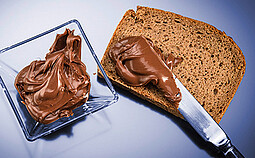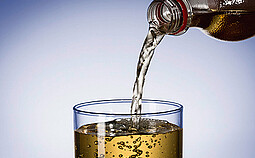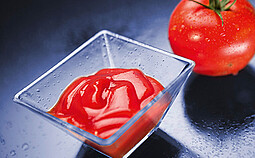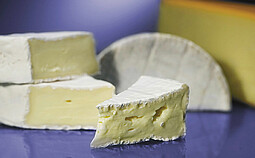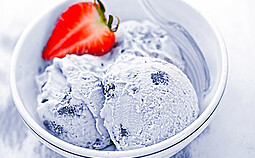Food Rheology
Rheological analysis of food helps you identify the appropriate texture of your products in order to fulfill customers’ expectations. This involves mouthfeel, also known as “psychorheology”, and drinkability. In this context food rheology helps you create the “feeling” that is expected from your products, for example, a certain creaminess or hardness, juiciness or smoothness, and brittleness or tenderness. This way you make sure that your customers always get products with the unique touch that is typical for your company. Anton Paar’s rheometers and viscometers are the right choice for a great variety of applications in the field of food rheology.
Life cycle of food products

Supplier delivering starch/powder/spices
The first step in the production chain of food products is the delivery of goods. As the quality of the raw materials also defines the quality of the end product, it is very important to ensure that your suppliers meet your quality control criteria for incoming goods.
Anton Paar provides you with the appropriate viscometers and rheometers for raw material quality control.

Production (mixing and formulation)
Large quantities of raw materials are converted into ready-made food products. During this step, full control of the manufacturing and production process is essential. Selecting the right ingredients, adjusting the right concentrations, and choosing the appropriate pre-treatment and temperature are all part of creating high-quality products.
Choose from Anton Paar’s broadest portfolio of viscometers and rheometers in order to maintain your product’s consistency and quality.

Filling and packaging
After production, filling and packaging are required for further industrial processing (distribution, storage, sale, and use). During this step it is necessary to use the right package for enclosing and protecting your product.
Therefore, checking the surface rupture quality, monitoring the right PET grade, or ensuring the correct viscoelastic properties for PET and recyclates are essential activities that are conducted by Anton Paar’s high-performance rheometers. Use a rolling-ball viscometer for samples with a low viscosity when it comes to determining the PET grades.

Storage
In order to make sure to preserve the quality of the produced food you need to be aware of the storage conditions and their effect on your product. The packaging material is also essential in this case. Among other things, food safety, customer satisfaction, food preservation, and reduction of food waste need to be ensured.
Testing the sedimentation and demixing behavior of the ingredients (also called shelf life), for example, ensures your product’s long-term quality. With the appropriate rheometer from Anton Paar you are able to achieve and maintain the product’s stability.

Application
The last step in the production chain is the consumption of your product by the customer. The rheological properties of your food product directly translate into measurable parameters such as spreadability, pourability, and smooth flowing as well as the customer’s sensations such as drinkability or mouthfeel.
Let Anton Paar help you maximize customer satisfaction with the appropriate viscometers and rheometers.
Find your solution
| Solution | Your benefit | Instrument | |
The powder material, for example flour, tends to segregate or demix during the powder mixing process. | Analyze the segregation and wall friction behavior of your samples using the powder flow cell. | Avoid problems in the production process due to changed powder flow behavior by adjusting the formulation of the raw material. | |
Uncover the exact viscosity of the raw material gum arabic solution prior to processing to ensure e.g. adequate thickening/emulsifying/stabilizing behavior. | Perform quick single-point quality control checks and flow curve measurements. Also determine the yield point as a quality control parameter. | Find out the amount required to ensure the right viscosity of the raw material for its different applications. | |
How can I adjust the right viscosity of the raw material gum arabic solution at different temperatures to control different production stages? | Perform quick single-point quality control checks and flow curve measurements (temperature-dependent tests). Also determine the yield point as a quality control parameter. | Adjust the amount required to ensure the right viscosity for the different production stages according to the production temperatures. | |
Do the incoming liquid raw materials of my fruit juice/purees or syrup have the right viscosity? | Perform quick single-point quality control checks and multi-point determination of the flow behavior and the yield point for quality control. | Adjust the ingredients to guarantee efficiency in different production stages and the appropriate quality of the incoming liquid raw materials. | |
How can I reduce sugar or fat but maintain the same texture? | Measure a flow curve for different formulations and check whether you can reach the same viscosity as of the original product. | Texture and viscosity are related. Rheological tests are an easy and time-saving way to gain insight into food textures. | |
How can I predict the sensory attributes of ice cream (psychorheology)? | Performing an oscillatory temperature test (Oscillation Thermo-Rheometry, OTR) gives you access to the rigidity, creaminess, or even scoopability of the ice cream sample. | As sensory attributes strongly correlate with rheological quantities, it is essential to perform a rheological analysis in order to evaluate new formulations or for quality control. | |
How can I adjust the right ingredients (emulsifiers or cocoa butter) for my chocolate products? | Perform single-point and viscosity curve measurements for quick quality control checks. | Choose the right ingredients of the chocolate to get the perfect consistency and texture for your chocolate products. | |
How can I follow the IOCCC method when it comes to the characterization of my chocolate products? | Conduct flow curves and temperature-dependent tests according to IOCCC. | Analyze the viscosity according to the IOCCC method. | |
How can I achieve the optimal conching process or coveraging of chocolate surfaces (in order to get even surfaces) when producing chocolate bars or chocolate products? | Carry out flow curve and yield point measurements at pre-defined temperatures. | Choose the right ingredients and amounts of ingredients for the chocolate to achieve perfect processing such as conching or coverage. | |
How can I choose the right type of milk (e.g. fat content or milk protein casein), concentration, composition, pre-treatment of milk, starter culture, and incubation temperature of yogurt and sour cream in order to ensure good processability? | Make quick single-point quality control checks and flow curve measurements and determine the yield point and thixotropic breakdown coefficient. | Adjust the ingredients to ensure the right viscosity for the different production stages. | |
How can I find the right viscosity of biscuit/bread dough to control the manufacturing and production process as well as the quality of the final product? | Determine flow curves (time- and temperature-dependent tests) as parameters for quality control. | Adjust the amount of ingredients to ensure the right viscosity for the final product and the different production stages. | |
How can I check the consistency of gluten-free bread dough? | Perform a frequency sweep within the linear viscoelastic range. | Make sure that the necessary 3D network structure, comparable with that of a standard bread dough, is created. | |
How can I measure the rheology of a pudding gel without rupturing the sample? | Oscillatory frequency tests within the linear viscoelastic regime do not rupture the sample. | Performing rotational tests may break the structure of your sample. Performing oscillatory tests within the viscoelastic regime prevents the structure from breaking. If necessary, the Cox-Merz rule can be applied to derive the complex viscosity. | |
How can I determine the viscosity of my meat sauce that contains very large particles? | Perform a test with the specially designed Ball Measuring System. | The Ball Measuring System allows you to evaluate flow properties of samples with very large particles within one single rotation of the ball. | |
Can I measure the yield point of my Greek yogurt without destroying the structure during sample preparation? | Use a four-blade stirrer with sharpened blades as the measuring system. | The sharpened blades will gently move through the yogurt without squeezing and irreversibly changing the structure of the bulk yogurt. | |
How can I determine the pasting temperature and final viscosity of starches? | Use the Anton Paar Starch Cell to analyze the starch pasting and gelatinization behavior at elevated temperatures. | The high heating and cooling rates required for starch pasting measurements are achieved by combining electrical heating with fluid-circulator-supported cooling. A special stirrer prevents sedimentation in the liquid phase. | |
How can I observe the dynamics of emulsion droplets during shearing? | Use the MultiDrive-microscopy accessory. Run a rotational or oscillation test and observe the droplet behavior during the measurement. Employing the counter-rotation mode of the TwinDrive rheometer you can focus on a stagnation plane between the two plates, which allows you to observe the same droplet throughout the entire test. | The droplet break-up helps you understand the stability of droplet microstructure in an emulsion under varying conditions. | |
How can I ensure high surface quality of packaging film without surface damages (e.g. a rippled surface)? | Perform rheological measurements to characterize the viscoelasticity of the used raw material in order to optimize process conditions. | You obtain consistent quality of the produced films, without surface imperfections or defects. | |
How can I ensure that the packaging film used for various foods (in contact with water or oil) and under different environmental conditions (tropical/arid/cold climates) shows constant quality over the whole shelf life? | Analyze the mechanical performance of the film in DMA tests under controlled temperature, varying humidity conditions, or in immersion. | You get the guarantee that your product reaches your customer in good condition, independent of climate conditions and possible interactions between packaged food and packaging material. | |
How can I ensure that the packaging film does not rupture during use? | Perform tensile testing to determine the strain- or stress at break. Perform dynamic mechanical analysis to investigate film brittleness (as indicated by the measured damping factor). | You achieve improved product quality based on a better selection of materials tailored to the product requirements. | |
How can I ensure the proper viscous and viscoelastic properties of my PET and recyclates or additional barrier materials to produce suitable preforms for beverages with injection molding? | Perform rheological tests to determine the shear rheological and extensional rheological properties of the raw materials. | Knowing the rheological properties enables the production of well layered preforms to ensure a stable production process and constant product properties of bottles used for beverages (e.g. constant low gas permeability). | |
How can I get suitable material parameters to optimize the processing conditions and mold design for the production of blow-molded and extrusion-blow-molded plastic bottles. | Determine relevant rheological parameters with shear rheological and extensional rheological testing methods. | Ensure high product quality with an optimum of material and production costs. | |
How can I find the right PET grade for my food/beverage packaging application (e.g. beverage, film, etc.)? | Measure intrinsic viscosity as PET grades are defined by intrinsic viscosity. | You get automatic calculation of intrinsic viscosity (and many other polymer parameters) without an external PC. Additional benefits are: reduced operating costs (low sample, solvent, and energy consumption) and excellent chemical resistance. |
|
How can I ensure that the spices in my salad sauce will not sediment during storage? | Evaluate the rheological properties with an oscillatory frequency sweep. At low frequencies you can check whether your formulation forms a 3D structure. The slope of the elastic modulus should tend to 0. | Easy and time-saving rheological tests (like a stability test) can replace longstanding storage tests. | |
How can I find the right formulation/ingredients for my hazelnut cream so that it can be easily spread on the bread? | Estimate the shear rate at which the hazelnut cream is spread over the bread. | Find out the right consistency and viscosity so that the hazelnut cream is easily spreadable on the bread. | |
How can I find and create the perfect mouthfeel (psychorheology) for a hazelnut cream? | Determine the viscosity at different shear rates and temperatures. | Adjust the ingredients to ensure that the hazelnut cream has the desired mouthfeel for the customer. | |
How can I obtain a solid behavior for my jam so that it does not immediately flow out when spooned? | Perform a multi-point determination of the yield stress as a quality control parameter for flow behavior. | Change the consistency in a way that the jam stays on the spoon and does not run off, but also that it is easily spreadable on the bread. | |
How can I prevent ketchup/mayonnaise from flowing down my french fries? | Use the 3 interval thixotropy test to simulate the emptying of the bottle and check your different formulations. | Measure the viscosity under very different conditions (rest – high shear – rest) with the 3ITT test to study the structure recovery. | |
When pouring mayonnaise out of the bottle, it has to flow out easily. | Determine the yield point as a quality control parameter. | Adjust the ingredients to ensure the right viscosity to get the mayonnaise out of the bottle. | |
I need to find the desired but also the appropriate feeling of drinkability (psychorheology) for clinical nourishment products for patients with swallowing problems (dysphagia). | Perform quick single-point quality control checks and multi-point determination of flow behavior. | Adjust the ingredients and their quantity to ensure the right viscosity to avoid issues with drinkability. Find the optimal smooth mouthfeel for the customers. |
You did not find your specific situation? Anton Paar still has the solution for your challenge. Just contact us for more information.

3-year warranty
- Effective January 1, 2020, all new Anton Paar instruments* include repair for 3 years.
- Customers avoid unforeseen costs and can always rely on their instrument.
- Alongside the warranty there is a wide range of additional services and maintenance options available.
* Due to the technology they use, some instruments require maintenance according to a maintenance schedule. Complying with the maintenance schedule is a prerequisite for the 3-year warranty.
Educational resources
Food rheology applications
Food rheology webinars
MASTER THE FLOW of your food products
Rheological characterization of food can help you define the food properties you want in your food product in order to fulfill not only your business requirements but also customer needs. Consistency and repeatability from quality or process control at the production line up to specific measurements in the development process of new products ensure food quality, which guarantees customer loyalty. Register now and learn how Anton Paar viscometers and rheometers help you master the flow of your food.
In this webinar you will learn about:
- The importance of the rheological properties of food in food production, processing, and quality control
- Psychorheology: Finding the suitable mouthfeel for your food products in order to fulfill customer expectations
- Applications of food rheology
Language: English
Trainer: Dr. Pablo Zardoya-Laguardia; Markus Nemeth
Webinar recordings on food characterization
Time to Evolve 13: Achieve Perfect Consistency of Ketchup or Mayo with Your French Fries

